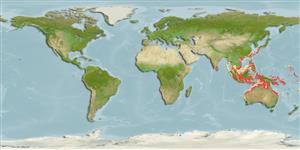Common names from other countries
Environment: milieu / climate zone / depth range / distribution range
Écologie
marin récifal; non migrateur; profondeur 10 - 50 m (Ref. 90102). Tropical
Western Central Pacific: Philippines, Borneo, Singapore, Papua New Guinea, the Arafura Sea (Ref. 9819) and Western Australia to Darwin and Brisbane, Australia.
Taille / Poids / Âge
Maturity: Lm ? range ? - ? cm
Max length : 45.0 cm TL mâle / non sexé; (Ref. 48635); common length : 35.0 cm TL mâle / non sexé; (Ref. 9790)
Épines dorsales (Total) : 9; Rayons mous dorsaux (Total) : 12; Épines anales: 0; Rayons mous anaux: 12. No pit present behind upper eye. Preopercular spines short, usually 2 subequal. Infraorbital ridge usually smooth over eye. Suborbital ridge bearing 1slight spine just behind eye, spine often obscure or lacking in adults. No dermal papillae on upper eye. Caudal fin with a large elongate dark blotch along upper and lower margins.
Found in shallow coastal areas and reef flats to about 50 m. Usually captured by spear fishing or with ichthyocide, occasional specimen taken by trawling (Ref. 9790).
Life cycle and mating behavior
Maturities | Reproduction | Spawnings | Egg(s) | Fecundities | Larves
Paxton, J.R., D.F. Hoese, G.R. Allen and J.E. Hanley, 1989. Pisces. Petromyzontidae to Carangidae. Zoological Catalogue of Australia, Vol. 7. Australian Government Publishing Service, Canberra, 665 p. (Ref. 7300)
Statut dans la liste rouge de l'IUCN (Ref. 130435)
CITES (Ref. 128078)
Not Evaluated
Menace pour l'homme
Harmless
Utilisations par l'homme
Pêcheries: pêcheries vivrières; pêche sportive: oui
Outils
Articles particuliers
Télécharger en XML
Sources Internet
Estimates based on models
Preferred temperature (Ref.
115969): 24.5 - 29, mean 28 (based on 546 cells).
Phylogenetic diversity index (Ref.
82804): PD
50 = 0.5625 [Uniqueness, from 0.5 = low to 2.0 = high].
Bayesian length-weight: a=0.00525 (0.00246 - 0.01120), b=3.04 (2.85 - 3.23), in cm Total Length, based on LWR estimates for this (Sub)family-body shape (Ref.
93245).
Niveau trophique (Ref.
69278): 3.9 ±0.7 se; based on size and trophs of closest relatives
Résilience (Ref.
120179): Milieu, temps minimum de doublement de population : 1,4 à 4,4 années (Preliminary K or Fecundity.).
Fishing Vulnerability (Ref.
59153): Low to moderate vulnerability (35 of 100).
